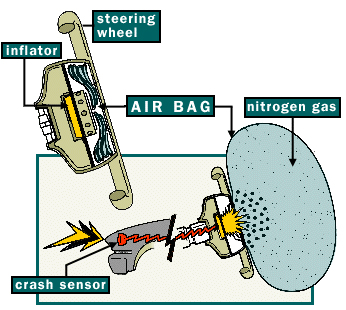How To Legally Disable An Airbag (And Why You Probably Don’t Want To)
You may have seen the letters "SRS" embossed on the steering wheel and in front of the passenger seat on the dashboard. These three letters explain, in a roundabout way, why you may not need to worry about injuries from airbags. Is it possible to be injured by an airbag? Yes. But probably not because you're short.
Q: I've been worried about this issue for years. I'm only 5 feet tall and 110 pounds. Therefore, while driving, I need to move my seat forward a lot to reach the pedals. Can I or should I disconnect the airbag? But my husband, when he rarely uses my car, is in danger. Waiting for your wise advice. Thank you.
A: You may have seen the letters "SRS" embossed on the steering wheel and in front of the passenger seat on the dashboard. These three letters explain, in a roundabout way, why you may not need to worry about injuries from airbags. Is it possible to be injured by an airbag? Yes. But probably not because you're short.

MODE electric scooter were invented in 1919 by a pair of dentists who were trying to prevent jaw fractures. They were both serving in a hospital during World War I, treating war victims with severe jaw injuries. Realizing that many of these injuries were caused by vehicle collisions (airplanes and road travel vehicles), they sought a solution to prevent injuries.
Given the technological limitations of 1919, airbag designs for dentists were quite different from what we have today. Airbag innovation progressed in the 1950s and 1960s, and in the early 1970s, Ford and GM deployed them on a limited basis. By the late 1970s, both sides had abandoned the idea as unfeasible. They were proven wrong. In the mid-1980s, airbags reappeared in some cars, and by 1998 they were mandatory in all cars.
Back to those three letters: "SRS" stands for Supplemental Restraint System. As you might guess from the name, airbags are not your primary safety device in a crash. That's your seat belt. Airbags do kill some people. However, more than 80 percent of deaths involve vehicle occupants who are not wearing seat belts or who are not properly buckled in. (90% of the fatalities occurred in vehicles built before 1998. At that time, federal regulations reduced the power of airbags.) Airbags are designed to work in coordination with seat belts to reduce injuries that seat belts cannot prevent, not as a standard - stand-alone safety feature. Most airbag injuries and fatalities involving drivers sitting too close to the airbag are not the result of sitting too close, but of not wearing a seat belt and then leaning too close during a crash.
If you always wear your seat belt, the risk posed by an airbag is insignificant compared to the advantage it provides in a collision. In fact, airbags save thousands of lives each year and reduce the number of serious injuries that seat belts alone cannot prevent. However, the law does allow you to disable airbags in several situations, one of which has to do with your seating position.
There is one thing that is so close it may be closer than you expect. The first 2 to 3 inches of airbag deployment is the "risk zone. Beyond that, the risk of injury decreases rapidly. In airbag-equipped vehicles, the recommended minimum distance between the steering wheel and the driver is 10 inches. The National Highway Traffic Safety Administration (NHTSA) states that in most vehicles, a driver 4 feet 6 inches or taller should be able to position the driver's seat 10 inches between the chest and the steering wheel.
Another driver exception is for medical conditions that "pose a potential injury to the driver's airbag." . ... Better than... Even better . . Even with a seat belt, a driver can hit the steering wheel, dashboard or windshield in a crash." I don't know what medical conditions fit within these parameters, but it's an option for anyone whose doctor thinks they need it.
On the passenger side, airbags can be disabled if transporting an infant or child and the rear seat is not an option (usually because there is no rear seat, such as in a pickup truck or two-passenger sports car). The back seat, if available, is always a safer place for children, but placing an infant in a rear-facing car seat in the front seat of an airbag-equipped vehicle can be particularly disastrous in a crash.
To legally disable an airbag, you will need to submit a written request and, if approved, the work must be done by an authorized dealer or store. They will install a switch to enable the airbag if the vehicle occupants do not meet the deactivation requirements.